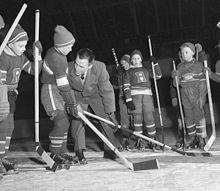Body check (sport)
In various sports, especially ice hockey , a body check is a hard physical effort by one player against another player. The points of contact of the check are usually shoulders and hips. If a body check is carried out normally against a player who is in possession of the puck , the body check does not constitute a rule violation in ice hockey.
42% of all injuries suffered by ice hockey players result directly from a body check. Some parts of the shoulder are relatively well protected by the protective clothing; other parts near the neck and neck are hardly protected, probably so as not to restrict mobility. It is not uncommon for injuries and - despite helmets - also for traumatic brain injuries that force long breaks or even retirement or cause permanent damage.
Rules of the body check in ice hockey
A body check in ice hockey is compliant if the following rules are observed:
- The check may only be performed against a player in possession of the puck.
- An attack from behind in the player's back is not permitted.
- As in all other scenes in the game, the check must be carried out without using a stick (cross checking ), fist, helmet, knee or elbow.
- At the moment of the check, the checking player may not jump off. His skates must touch the ice surface continuously.
General ban on body checks
Body checks are generally prohibited in women's ice hockey. The same often applies to teenagers or children, as the risk of injury is too high. They are also banned in some university leagues.
Web links
- Check it out. hockeycanada.ca, accessed on April 14, 2009 (English, large portal on the subject of “body checks in ice hockey”).
- The body check experiment. innomic.com, accessed on June 22, 2015 (Which forces and accelerations act on the player during the body check?).
Individual evidence
- ^ Ice Hockey Fact Sheet, The British Columbia Injury Research and Prevention Unit (BCIRPU). (PDF; 559 kB) (No longer available online.) British Columbia Injury Research, archived from the original on August 28, 2008 ; accessed on April 14, 2009 . Info: The archive link was inserted automatically and has not yet been checked. Please check the original and archive link according to the instructions and then remove this notice.
- ↑ In ice hockey, the number of severe concussions increases dramatically. Many players are about to end their careers (RP December 8, 2012)
